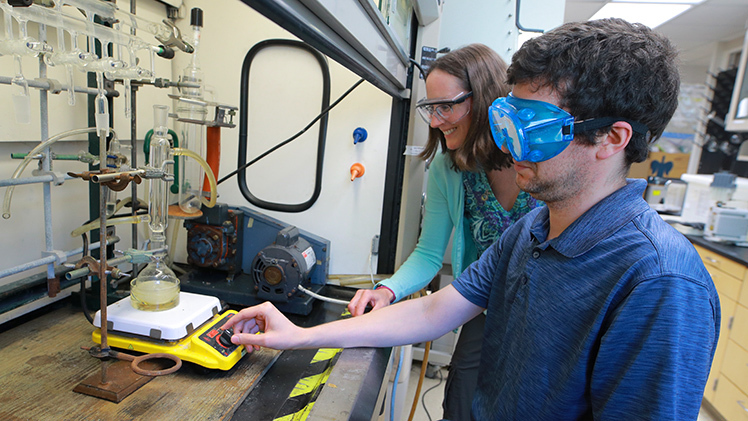
Our guest blogger, Dr. Cora Lind-Kovacs, is an academic researcher, professor and associate chair of The University of Toledo’s Department of Chemistry and Biochemistry. Below, she explains the benefits of industry and academia – including UToledo – joining forces on important research to create longer-life lead batteries. She predicts great synergy ahead! [See project news release and fact sheet.]

Research Collaboration is Critical to Meet DOE’s Initiatives for Grid Energy Storage
Lead battery science is one of the key research initiatives identified by the U.S. Department of Energy (DOE) in its 2020 Grid Energy Storage Technology Cost and Performance Assessment.1 It reports that, “As demand for energy storage continues to grow and evolve, it is critical to compare the costs and performance of different energy storage technologies on an equitable basis.”
Joining Forces to Help Solve Energy Storage Challenges
This energy storage challenge reinforces why funding research partnerships between industry and academia is so important, like the one recently announced between UToledo, U.S. lead battery companies and the U.S. Department of Energy’s Argonne National Laboratory. The newly formed two-year collaboration aims to create longer-life lead batteries.
As a chemist, this an exciting opportunity to use our expertise to work closely with several companies and help address a relevant industrial problem. Here’s a lesson that I learned a long time ago: Basic research is important, but without someone to take it further, it can only go so far. Scientists love to find challenges that may open the door to what we call “transformative research.” But without engineers who can take such a discovery and make it into a device, it remains a curiosity. Without companies that can upscale things and make them into useful consumer products, the benefit to society will remain limited.
Yet industry and academia are often seen as completely disconnected entities that have little in common. As an academic researcher, I understand why. My job is to create new knowledge, to make discoveries that allow for high-level publications and, hopefully, funding for research from government agencies. In the process, we have the liberty of committing time and resources to unpredictable outcomes that could result in applications we cannot yet describe. When something is potentially transformative, it is okay to take big risks, as long as there is the potential for equally big rewards.
This is in stark contrast to the business world. Industry must focus on a sustainable business model that creates useful products for which there is a market.

Intrigued by Lead Battery’s Profile: Great Performance, Availability, Low-Cost
When I started my independent career at the University of Toledo, I knew about the existence of lead batteries and how useful they are. After all, I owned a car and once had to replace its battery. As a chemist, I knew about the basic battery reactions that convert both lead and lead dioxide into lead sulfate, and the elegant use of lead sulfate’s poor solubility to make it adhere to the electrodes so that the reactions can be reversed and the battery recharged. I even got to teach these concepts in my General Chemistry class when we covered batteries. Yet, I never stopped to think about how much more there is to lead batteries. To me, they existed; they worked very well, and they were readily available at a reasonable price.
Crown Battery Inquiry Raises Curiosity
Fast forward a couple of years when I was introduced to an industrial researcher from Crown Battery who wanted to do some advanced diffraction experiments in our instrumentation center. I was asked to help with the analysis, as I am the local expert on powder methods. Of course, when researchers meet, they start to talk. I was fascinated by the many facets of lead batteries that I never knew existed, which included the fact that they contain lignosulfonates. When presented with some of the challenges that the battery industry faces while trying to expand into new areas like grid storage and deep discharge, I started to do what academic scientists love to do – ask curious questions!
Pinpointing Opportunities with Molecular Design
A discussion developed on how one could go about answering such questions. It quickly became clear that taking lead batteries to the next level would require some very “basic research” to understand what happens at an atomic level when these wood-based battery additives interact with the various lead species involved in the discharge/charge cycles. A scientist’s playground opened up before my eyes – observations that indicated that we do not understand what happens, and there are many opportunities to completely change how we look at these systems!
I was happy to put my thoughts and questions on paper, which eventually led to the inception of our project supported by Crown Battery, Clarios, East Penn Manufacturing, Ecobat and EnerSys. In this project, our collaborators at Argonne National Lab and our group at UToledo will study model expander molecules that mimic certain portions of lignosulfonates to determine how these complex biomacromolecules interact with the lead species, and how we can simultaneously retain their beneficial properties and overcome their shortfalls through molecular design.
Taking Lead Battery Research Insights to Market
This process has helped me see the untapped potential of, and considerable synergy that can arise from, industry-academia collaborations. As academic researchers, we have a lot to offer to industry, if we are simply willing to engage in conversations, listen, learn, and then offer our expertise to relevant problems, instead of solely chasing after new and unexplored fields. We are often completely unaware of the problems that companies encounter. Yet our expertise can produce insights that can help well-established industrial branches expand into new fields of application.
We may even make that transformative discovery on a problem for which there are industrial partners, poised to take that discovery and put it to great use immediately. Hopefully, that includes extending the life of lead batteries to help meet DOE’s goals for grid energy storage.
1 DOE/PA-0204 December 2020







